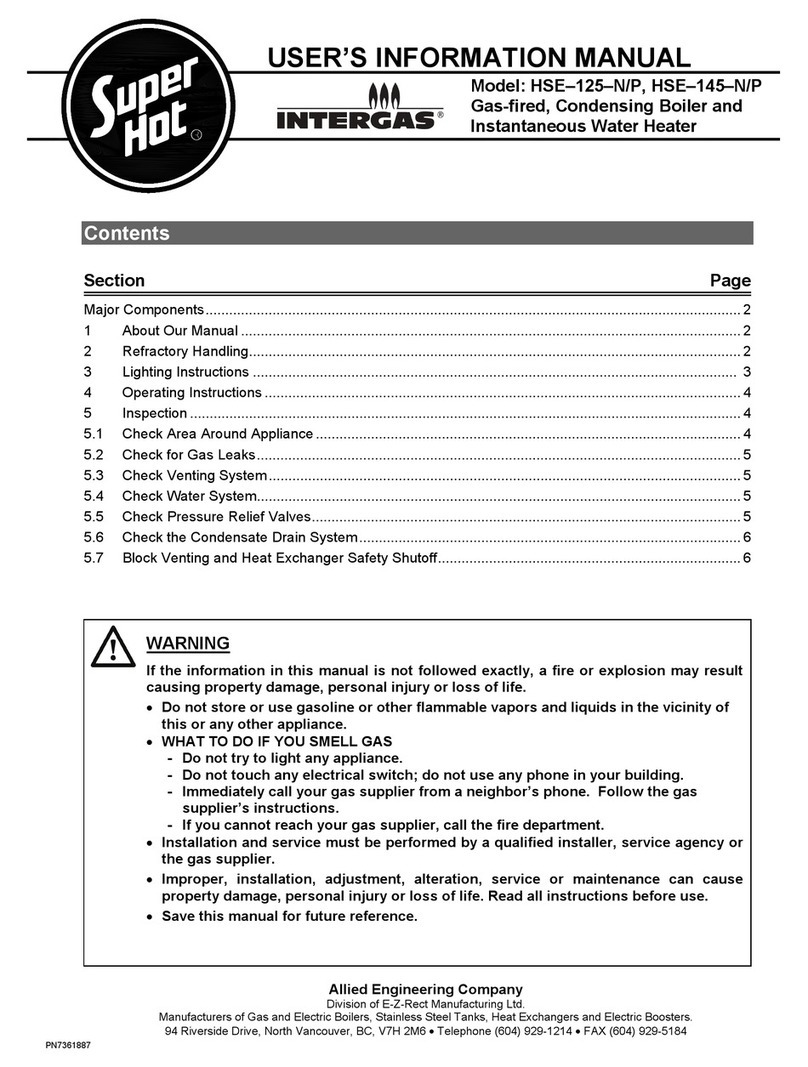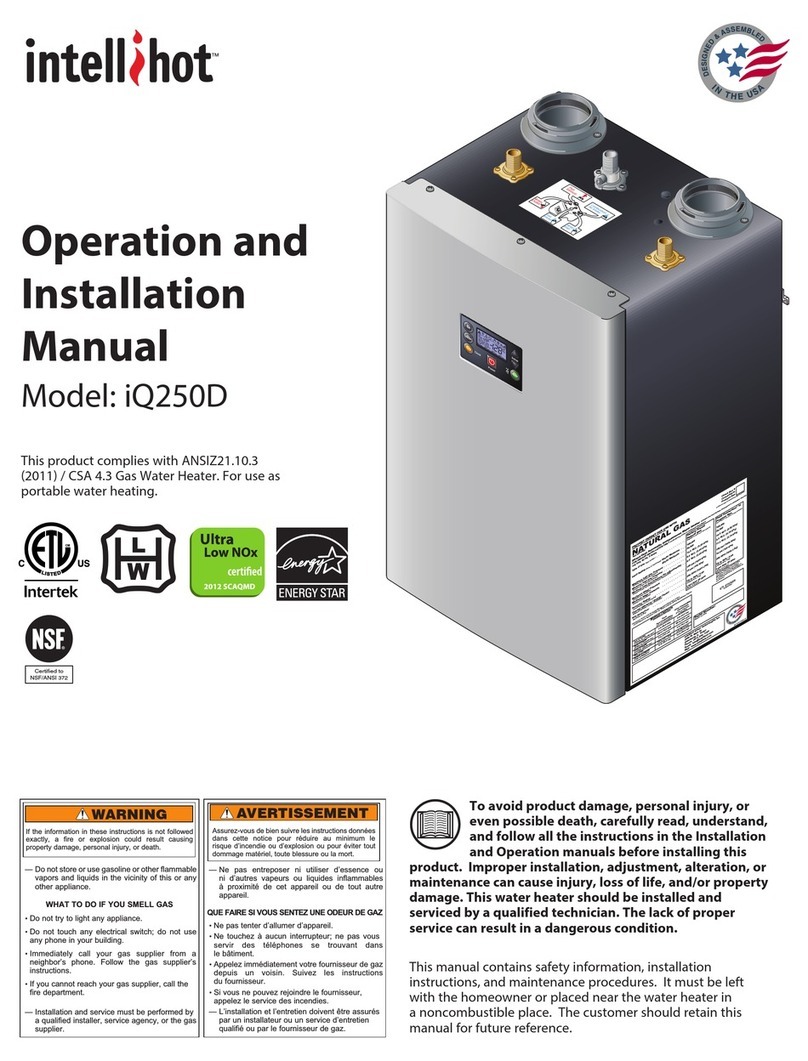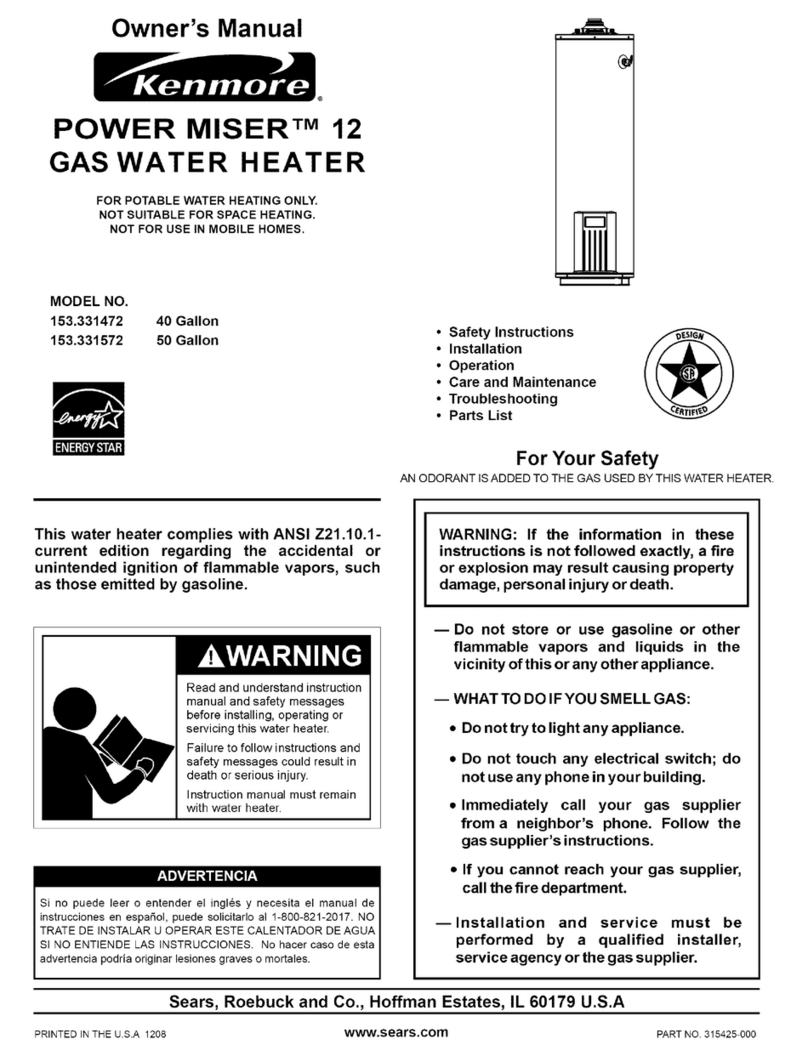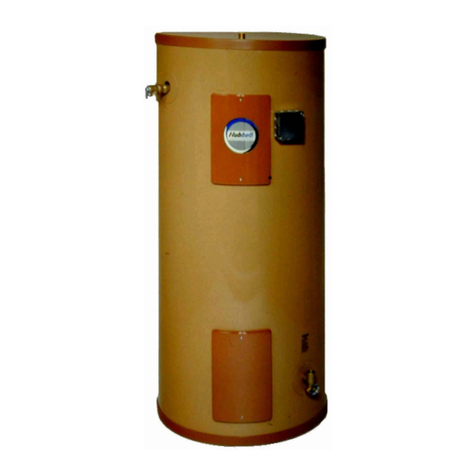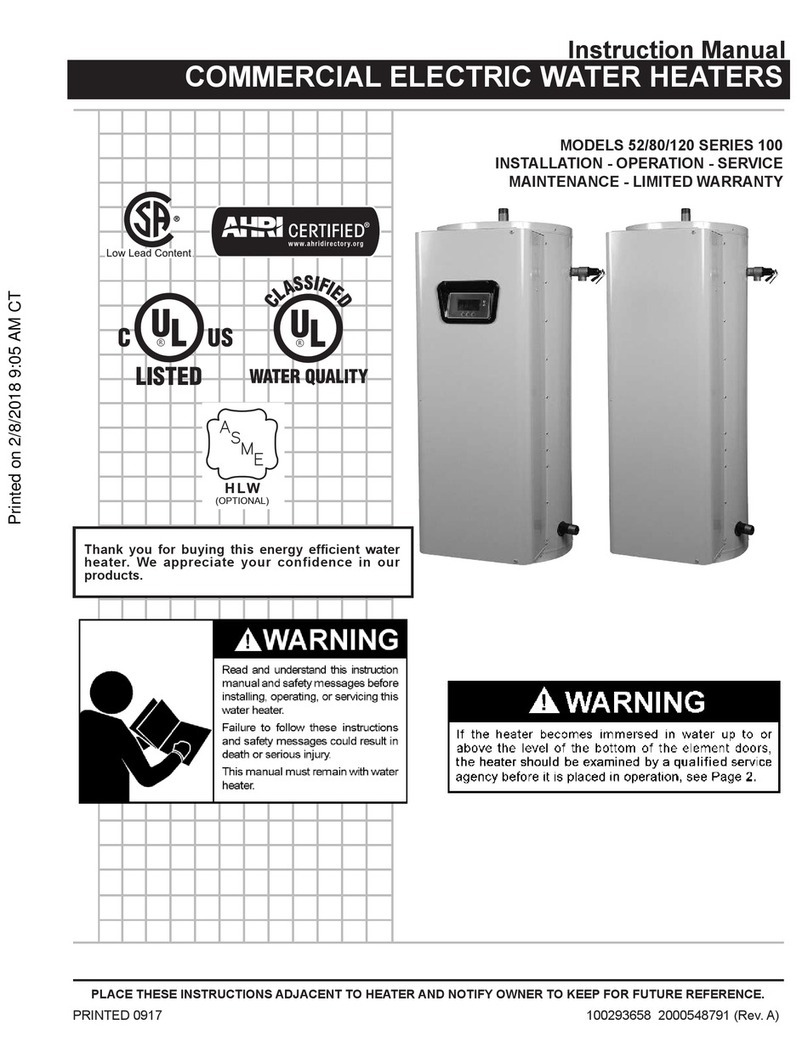Econergy THD3500 User manual

THD3500 HEAT PUMP WATER
HEATER INSTALLATION GUIDE
FOR QUALIFIED PERSONNEL ONLY
14072022

2
NOTE TO INSTALLERS:
Installation must be completed by qualified and licensed
Tradesmen to National Codes and in strict accordance with this
manual.
WARNING:
A pre– made CAT –5/6 cable is required for installation of Econergy
heat pumps

3
CONTENTS
Location of the Water Heater Unit ___________________________ 4
Installation Design _______________________________________ 5
Design to Avoid Cavitation ____________________________ 5
Distance from Hot Water Cylinder ______________________ 5
Wetback Systems________________________________________ 5
Solar Water Heating Systems ______________________________ 6
Ring Main Management ___________________________________ 6
Hot Water Cylinders ______________________________________ 7
New Construction ___________________________________ 8
Retrofit ___________________________________________ 8
Ordering Econergy Accessories_____________________________ 9
Installation ____________________________________________ 11
Typical Installation Detail _________________________________ 13
Installation Procedures___________________________________ 14
Mounting Systems _________________________________ 14
Pre-Wiring & Pre-Plumbing for Renovations & New Builds __ 15
Piping Diagrams ________________________________________ 16
Retrofit to Generic Single Inlet Hot Water Cylinder ________ 16
Retrofit to Coopers Ready Mains PressureWater Cylinder _ 17
Connection to Econergy HP Ready Hot Water Cylinder ____ 18
Piping Instructions ______________________________________ 19
Commissioning_________________________________________ 21
Troubleshooting ________________________________________ 23
Important Information ____________________________________ 26
Field Wiring Diagram ____________________________________ 27
Typical Heat Pump Ready Water Cylinder Product Specifications _ 28
Econergy HP Series Water Heater Specifications ______________ 30
Company Information____________________________________ 31

4
LOCATION OF THE WATER HEATER UNIT
Econergy® water heater units are designed to be installed outside, in the ceiling
cavity (if one exists), under the house or in a garage, adjacent to the hot water
cylinder (HWC). The Econergy® water heater should not be located within living
areas as the unit produces cold air.
Location of the Econergy® water heater will be determined by a combination of
factors including proximity to the hot water cylinder, proximity to bedrooms and
whether there is usable space where the unit is going to be located.
For installation to existing homes, the unit should be installed with a maximum
insulated pipe run of 9 metres.
For new homes, the layout should be designed so that the unit can be installed as
close to the HWC as practical within the 9 metre maximum pipe run. The HWC can
be installed inside or outside but as close to main points of use as possible.
Econergy® Water Heaters must be installed in a well-ventilated
space outside the living areas
The Econergy® Water Heater emits 52 dbA at 1.5 metres
(THD3500) and should not be installed adjacent to bedrooms.
Ensure that the unit is located so that noise will not affect the
residents. The unit must be seismically restrained and located
away from bedrooms to avoid noise breakthrough.

5
INSTALLATION DESIGN
Design to Avoid Cavitation
The installation must be designed so that the unit will operate reliably and with no
water flow issues due to cavitation.
Cavitation of the circulating pump may occur when there is less
than 50kPa pressure at the heat pump inlet. This can lead to a
malfunction of the Econergy® water heater and MUST BE AVOIDED
by ensuring adequate pressure at the system inlet.
To ensure successful operation of the Econergy® water heater on open vent
application where operating pressure is less than 50kPa (or 5m static head), a valve
vented system should be used. This has the added benefit of increasing the pressure
of supply in the house. The installer should be aware of and avoid adding a relief
valve to an old HWC of questionable structural integrity since it could cause the HWC
to fail.
Distance from Hot Water Cylinder
The Econergy® water heater should be mounted as close as possible to the HWC to
ensure best efficiency. This is because each leg of supply/ return piped water loses
its heat during the off-cycle despite being insulated. The cylinder should be located
within 9 metres of the Econergy® water heater for retrofit installations and directly
adjacent for new installations.
WETBACK SYSTEMS
The Econergy® system cannot be used with a wetback system
where the piping design allows a thermosyphon to develop
Wetback systems involve large bore copper pipes running into the cylinder and back
again. Because the heat source is uncontrolled, temperatures can rise to 100°C,
generating steam. Plumbing codes dictate that an open vent is used to eliminate the
possibility of an explosion occurring due to rapid pressure rise in the system.
Econergy® units can be combined with wetback systems but only with strict
constraints as the temperature limit on the Econergy® water heater is 80°C. The
Econergy® water heater unit must be mounted level with the hot water cylinder or
below, and the piping designed to eliminate a thermosyphon loop to stop the
possibility of over temperature hot water circulating from the cylinder to the unit.

6
SOLAR WATER HEATING SYSTEMS
The Econergy® system cannot be used with a solar water heating
system where the piping design allows a thermosyphon loop to
develop
Solar water heating systems, like wetback systems, are usually uncontrolled
systems. Temperatures can rise to 100°C, boiling the water. As the Econergy®
system is super-efficient it would not normally be required to integrate the unit with a
solar water heating system, however if this was specified or required by the customer
then the piping design (as per wetback) must be designed to avoid thermo-syphoning
of high temperature water through the unit while not running.
RING MAIN MANAGEMENT (OPTIONAL)
A ring main should not be used on an Econergy cylinder setup without management
unless it is operated from a separate cylinder. Ring main management is a software
update that can be installed during production. A switch or PIR sensor(s) can be
wired to the heat pump and the heat pump will control the ring main circulation pump
(ring main pumps are not supplied as part of a typical Econergy system unless
specifically requested). Once the mechanism is triggered, the ring main pump will be
activated for 60 seconds to flood the ring main with hot water. A minimal amount of
hot water may be reintroduced back to the cylinder as a result. The ring main pump
will then be locked out for 30 minutes regardless of additional triggers.

7
HOT WATER CYLINDERS
The Econergy® water heater requires a well-insulated hot water cylinder to function
correctly. The tank must be sized to the maximum anticipated draw off in an 8-hour
period so that the consumer does not run out of hot water. As a guide, we
recommend 300L for a family of 4. The water heater unit can be retrofitted to any
electric cylinder as long as it has PU or EPS insulation. Econergy® water heaters
cannot be installed into gas HWC’s as they are generally inefficient and there is no
electrical backup .
Econergy Heat Pump Ready HWC—Recommended Storage Sizes
Household Size
#Adults Recommended Size Ordering Code
2180L EC180L
3250L EC250L
4 – 6 300L EC300L
6+ / High Use 350L+ EC [capacity] L Custom
The Econergy cannot be retrofitted to gas hot water cylinders, or
any storage tank that cannot deliver more than 50kPa pressure to
the pump inlet.

8
B) Retrofit
Retrofit can be made to any electric hot water cylinder with PU or EPS in good
condition by teeing into the cold-water line just before the tank isolation valve and by
fitting a tank outlet fitting (code HPTP) into the hot water outlet line. It is
recommended not to fit a pressure relief valve to an old LP cylinder as this could
cause leaks.
A) New Construction
We recommend Econergy® heat pump ready hot water cylinders. Available in mains
pressure stainless steel, these contain dual 20 mm inlet fittings, dedicated 20 mm
return fittings and dual sensors integrated into the tank. They are guaranteed from
the factory with a 10-year warranty. Use of Econergy® heat pump ready cylinders
avoids any potential warranty issues resulting from modification to fit sensor pockets.

9
ORDERING ECONERGY ACCESSORIES
Part No. Application Picture
Tank Pocket
HPTP
Tank Pocket - For
retrofit to Rheem
Stainless Solar
Ready HWC
Condensate Fitting
PF0128-B
For outdoor
installations requiring
a condensate drain
Generic Retrofit Kit
HPGRK For retrofit to existing
hot water cylinders
Coopers Solar Ready
Retrofit Kit
HPCRK For retrofit to Coopers Solar
Ready Hot Water Cylinders
Dux/Rinnai Retrofit Kit
HPTSK
For retrofit to Dux
Proflow and Rinnai
Hotflow Hot Water
Cylinders (aka Tank
Sensor

10
This page is intentionally left blank

11
INSTALLATION
Standard Specifications
No. Installation Component Approved Specification
Plumbing Installation
1Piping systems from Heat
Pump Unit to Hot Water
Cylinder
15mm nominal bore piping
(no more, no less).
Dux or Buteline Polybutylene
REHAU PE
Kembla PEX Fusiotherm
Copper AS/NZS compliant
2Pipe Line Fittings Dux Secura, REHAU, Fusiotherm,
Kembla PEX or AS/NZS Standard
DR brass fittings
3Flexible Hoses NOT ALLOWED
4Ball Valves Use only full flow 15mm tee handle
valves. Bugatti, PWL, Econergy
5Pipe Insulation Min 13mm wall Armaflex or
approved equivalent. All piping to
be fully lagged along its length
6Max Pipe Distance 9 m flow 9 m return

12
No. Installation Component Approved Specification
Electrical Installation
1Low Voltage Cable CAT5 UTP, 24AWG and rated to 1
amp max
2Main Cable 2.5 TPS, 2 x 2.5mm2 + E,
compliant to AS/NZS5000.2
3MCB To suit electric back element
rating. Max permissible 20A

13
TYPICAL INSTALLATION DETAIL
Installation shall be made to and compliant with, the attached drawings.
Figure 1: Typical Installation Detail—Indoor HWC/ Outdoor Unit
Figure 2: Typical Installation Detail—Outdoor HWC and Unit

14
INSTALLATION PROCEDURES
Adequate access and space for service must be allowed for all types
of installation
Mounting System
A) Outdoor Mounting.
Lay the unit on its side using the cardboard packing as protection. Drill holes for
mounting bolts and rubber pads. Place heat pump on rubber pads with holes aligned
and bolt to the ground.
B) Closed Garage Installations.
Cold air leaving the unit must be ducted to the outside without loss of air flow. A fresh
air supply must also be installed to ensure that the correct air flow through the heat
pump is maintained.
1. Windows are insufficient for this purpose.
2. Ensure no objects can be placed within 500 mm of the heat pump as
3. this will reduce its efficiency.
4. Allow for drainage of water naturally produced by the cooling coil (evaporator)
from within the heat pump
C) Open Ended Garage Installations.
The heat pump must be installed on brackets as high up to the ceiling as possible
with louvers fitted to direct the cold air from the unit to fall to the floor. This allows the
cold air to flow along the floor to the outside and the heat pump receives warmer air
from under the ceiling which makes the unit considerably more efficient. The height at
which the heat pump is installed must also allow the covers to be lifted vertically over
the top of the unit for service and electrical installation.

15
Do not invert the outdoor unit to attach the mounting feet or at any
other time during installation. This may cause damage to internal
components and may void the warranty
Do not wall mount the unit on any timber framed wall (with or
without brick veneer)
Please Note: If the heat pump is installed in a coastal situation, efforts should
be made to protect the unit from salt spray to avoid premature corrosion.
Pre-Wiring & Pre-Plumbing for Renovations & New Builds
This is required if piping and/or cables need to run through walls/floors/roof cavities
etc. Run 1x Mains cable and 1x CAT-5 UTP cable allowing an extra 2m free play at
either end. Run 2x 15mm pipes, fully insulated along their length.
A pre-made CAT- 5/6 cable is required for installation of Econergy
heat pumps

16
PIPING DIAGRAMS
Figure 3: Retrofit to Generic Single Inlet Hot Water Cylinder
(eg Rheem NZ)
Econergy Accessories Required
No Part Number Description Purpose
1HPGRK Generic Retrofit Kit
(comprises tank fitting
and tank sensor kit).
Allows retrofit to any
standard hot water
cylinder
1. Cylinder must be post 1988 and in good condition
2. Fitting of Tank Sensor kit (HPTSK) may void HWC’s manufacturer warranty
3. Ensure minimum pressure of 50kPa met on low pressure installations (may
require fitting of relief valve to open vent HWC)

17
Figure 4: Retrofit to Coopers Ready Mains Pressure Hot Water
Cylinder
Econergy Accessories Required
No Part Number Description Purpose
1HPCRK Coopers (Solar Ready)
Retrofit Kit
Comprises HPTF
Tank Fitting and
HPTP Tank Pocket
1. DO NOT connect return line to heat pump to solar connection!
2. Ensure minimum pressure of 50kPa met on low pressure installations (may
require fitting of relief valve to open vent HWC)

18
Figure 5: Connection to Econergy® Heat Pump Ready Hot
Water Cylinder
No Econergy Accessories Required
1. TPR valve is provided in element cover.

19
Apply thermal paste to the tank sensor. Push tank sensor through the tank sensor
cover and lodge it in the tank sensor mount.
Apply 9cc of thermal paste (supplied with Tank Sensor) to the back of the tank
sensor mount and place it in the drilled hole against the inside layer of the cylinder.
PIPING INSTRUCTIONS
1. Plumb Water Heater to Hot Water Cylinder
Plumb the water heater unit in accordance with the correct piping diagram to match
the type of cylinder being connected to. Ensure inlet (blue) of heat pump is connected
to bottom of HWC and outlet (red) of water heater is plumbed to top of the HWC. All
plumbing to be carried out in accordance with AS/NZS 3500 and NZ BC Section G12
2. Mount Hot Water Backup Run Electrical Cables
The hot water backup module (HWB) shall be mounted close to the hot water
cylinder in a location that is easily visible to the hot water user. All wiring to be
completed according to AS/NZS3000 and Field Wiring Diagram in page 23 of this
manual. Fit isolators next to HWC and within 1 metre of the water heater unit in an
easily accessible location. Run all cables from heat pump unit through conduit or
trunking to the hot water cylinder location.
3. Tank Sensor Mounting
a) Econergy Hot Water Cylinder. This comes with dual sensors, upper and
lower. Insert the lower tank sensor into the pocket about 1/3 of the way up the
HWC and secure with adhesive or silicone sealant. Take both sensors and
plug them in to their respective locations in the hot water backup (HWB)
module TTu/Ttl
b) Coopers or Rheem Solar Ready Hot Water cylinder. The plumbing installer
needs to thread a tank pocket into the solar port of the hot water cylinder and
ensure there are no leaks. Apply thermal paste to the tank sensor and insert
the tank sensor into the pocket. Secure the tank sensor with building adhesive
or silicone sealant. Plug the tank sensor into the header marked J4 or Ttl on
the circuit board of the HWB module
c) Generic Hot Water Cylinder. Drill a 51mm (1/2”) diameter hole in the hot
water cylinder jacket at a height ¼ (25%) of the way up the cylinder, when
measured from the bottom.
Adjust the foam core supplied such that when inserted with the pocket into the hole it
sticks out by at least 10mm. Insert the tank sensor foam core, and then attach the
tank sensor cover using the screws provided. Pilot holes of 3.2mm (1/8”) diameter
will need to be drilled for these screws. Plug the tank sensor into the header marked
J4 or Ttl on 1 the circuit board of the HWB module.

20
4. Electrical Connections
All electrical connections must be made, by a licensed tradesman, according to the
diagram below. The appliance must be installed in accordance with AS/NZS
3000:2000. A means for disconnection must be incorporated in the fixed wiring. A
Certificate of Compliance must be issued by the installer.
5. Condensate drain
Condensate drains must be run where the unit is discharging on a concrete path or
other location where wetness/mould is not desirable.
Use PF0128-B accessory. Mount the fitting into the punched hole at the bottom left
rear of the water heater unit. Run hosepipe to the nearest drain location.
Only Econergy® factory sensor cables provided with the unit shall
be installed. Use of substitute sensor cables or splicing cables may
void warranty.
Do not wall mount the unit on any timber framed wall (with or
without brick veneer)
Table of contents
Popular Water Heater manuals by other brands
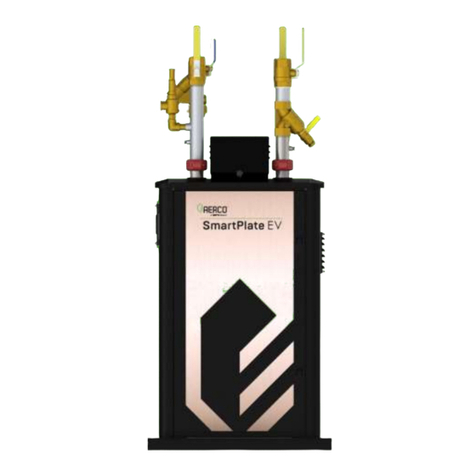
Watts
Watts Aerco SmartPlate EV Installation, operation & maintenance manual

Westinghouse
Westinghouse WGRTNG199 User's information manual
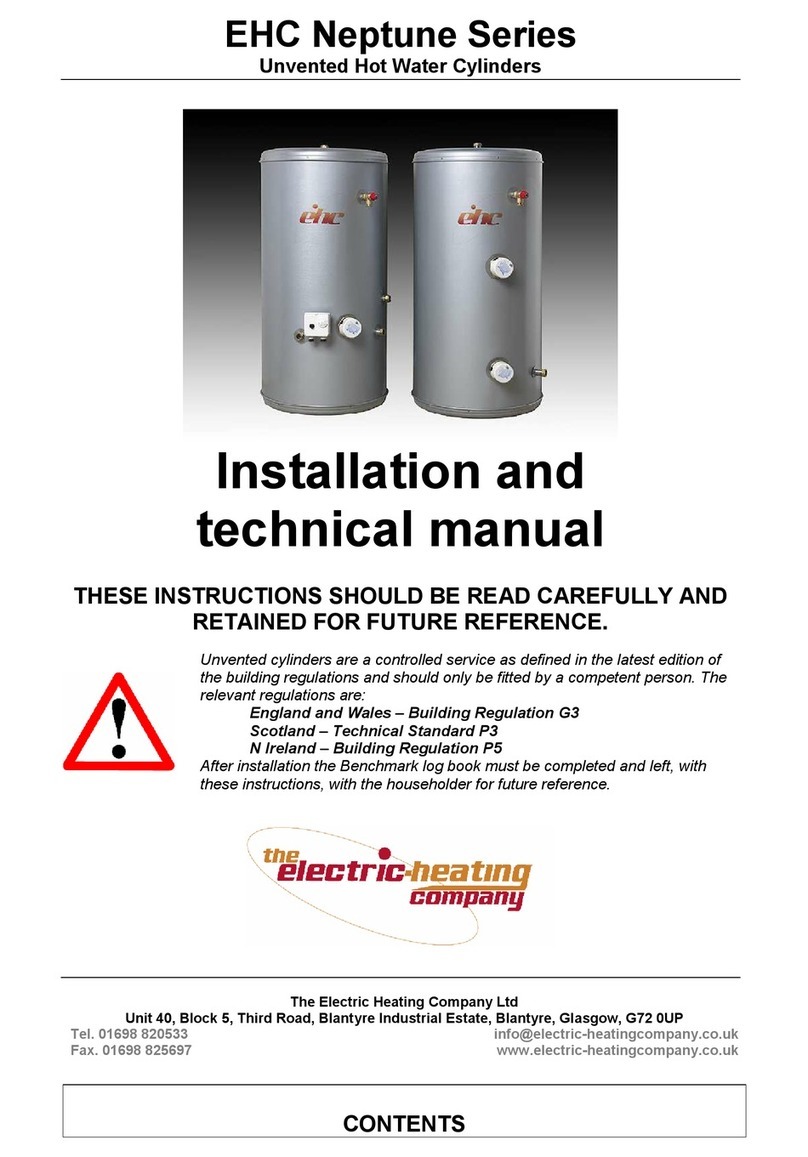
EHC
EHC NDIR120L Installation and technical manual

ENKA
ENKA MILKER 50 instruction manual
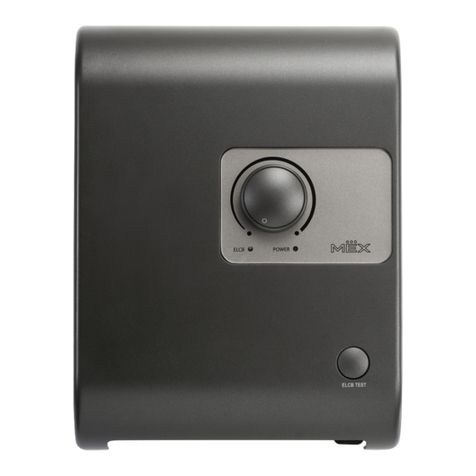
Mex
Mex CUBE 35E instruction manual

Viessmann
Viessmann Vitocell 100-E Installation and service instructions

Spheros
Spheros Thermo S 230 Workshop manual
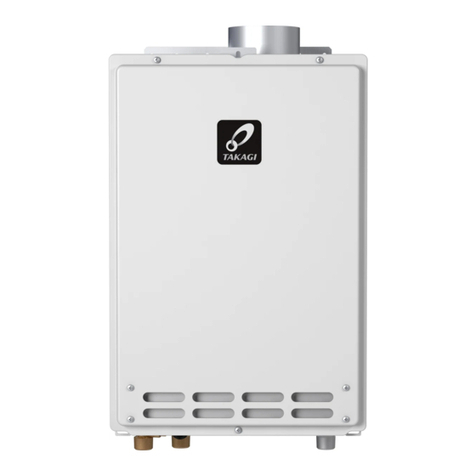
Takagi
Takagi T?KJr2?IN Installation manual and owner's guide

Atlantic
Atlantic Flat 30 manual

Rinnai
Rinnai Ai 350 Instructions for use, installation, and connection
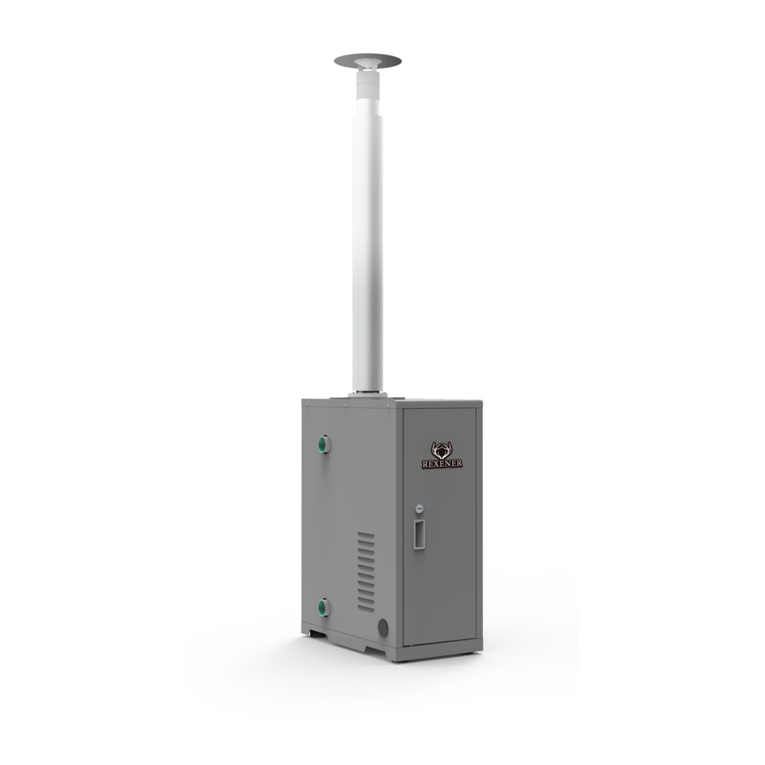
REXENER
REXENER PR-200 user manual
Beacon/Morris
Beacon/Morris twin-floIII installation instructions
